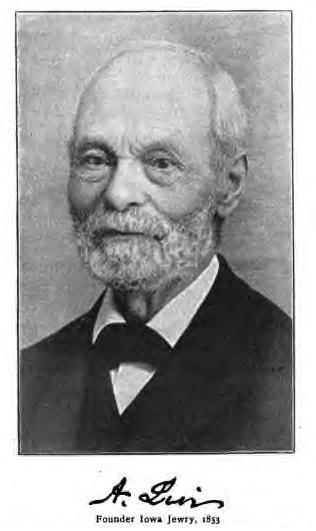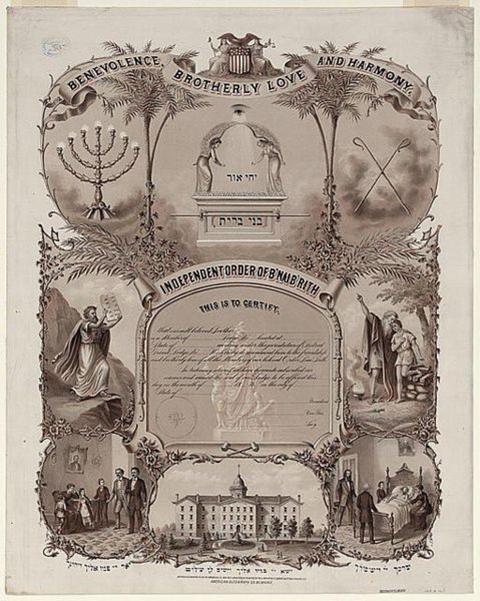Encyclopedia Dubuque
"Encyclopedia Dubuque is the online authority for all things Dubuque, written by the people who know the city best.”
Marshall Cohen—researcher and producer, CNN
Affiliated with the Local History Network of the State Historical Society of Iowa, and the Iowa Museum Association.
JEWISH COMMUNITY: Difference between revisions
No edit summary |
No edit summary |
||
| Line 1: | Line 1: | ||
To tell the story of Temple Beth El, one has to turn the clock all the way back to 1857, the year that Dubuque’s first Jewish resident (arrival 1833) formed an informal worship community with several other recent entrants to the city. (In Judaism, while a community is best served by a spiritual leader who is learned in Torah, ritual and liturgy, services do not need to be conducted by a priest. Instead, a quorum of ten adults is required to fulfill the obligation of prayer, and any member can conduct lifecycle events and services.) | |||
[[Image:levi.jpg|left|thumb|150px|Alexander Levi]] | [[Image:levi.jpg|left|thumb|150px|Alexander Levi]]By 1867, with new Jewish arrivals from the East, the group had coalesced into a bonafide congregation with 20 member families, a paid Rabbi and Chazzan, or singer of the liturgy; a paid schochet, the person who slaughtered meat in a ritually proper or kosher way; and a religious school where twenty-five children received instruction in Hebrew and German. By the 1880s, with the support of Alexander Levi, the congregation had grown; had a name, B’nei Jeshrun (Children of God); served 100 member families; and met in a rented hall on 5th and Locust [[STREETS]]. In 1890, Bnei Jeshrun had changed its name to B’nei Abraham (Children of Abraham). A second congregation, Knesses Israel (gathering or assembly of Israel), had opened on 15th and Elm possibly to serve recent arrivals from Poland, Russia and Lithuania whose liturgy and culture differed from earlier French and German settlers. A third group Kehilla (literally “community”) appeared for a time and may have been a fraternal organization or a separate prayer quorum or minyan. The Jewish community was firmly established; local newspapers regularly ran stories about Jewish holiday services, celebrations and other temple events. | ||
In 1901, Kenesses Israel had 125 families and was meeting on 10th and Washington. Around that time, the Hebrew Ladies Benevolent Society provided funds for the congregation to buy a lot and 2-story house on Maple between 17th and 18th, which they remodeled into a synagogue. The congregation – forerunner of Temple Beth El - lasted another 35 years; until the [[DUBUQUE PACKING COMPANY]] bought the property and, shortly after, demolished the building. | |||
[[Image:certificate.jpg|left|thumb|150px|Certificate of membership in B'nai B'rith]]The current Temple Beth El (Children of God) was funded largely by B’nai B’rith Dubuque Lodge 1029 (B’nai B’rith, meaning Children of the Covenant, the oldest continuously operating Jewish service organization in the world. It was started in 1843 and chartered in Dubuque in 1927) | |||
The temple – serving 85 member families - was dedicated in 1939; at a time when Hitler was storming Europe and anti-Semitism was being espoused here in the U.S. by people like Henry Ford and Father Charles Coughlin. | |||
Dubuque and its citizens, however, embraced the congregation. The laying of the cornerstone was an ecumenical affair attended by Jews and non-Jews. Synagogue President, Louis Rotman laid the cornerstone. B’nai B’rith President, Meyer Zuckerman chaired the program and the speakers were Rabbi Monroe Leavens of Des Moines, District Court Judge P.J. Nelson, a Catholic; and Rev. William E. Brehm of the First Congregational Church now [[FIRST CONGREGATIONAL UNITED CHURCH OF CHRIST]] of Dubuque. | |||
Today's Temple Beth El is a small, but vibrant worship community whose families hail from within a 90-mile radius and represent an age span from 6 months to 94. Some members have lived in the region nearly all their lives and have connections back to the temple's earliest days. Others were raised elsewhere, came to the region for school or work, and settled down to build lives within the Temple Beth El family. The congregation has welcomed some recent additions, as several young people have moved to the area to begin careers. | |||
Temple Beth El members represent teachers, professionals, leaders of businesses and organizations, and students. The congregation has a strong social justice mission, and many members are active volunteers for area charities and nonprofits. Temple Beth El provides an opportunity to strengthen Jewish identity and deepen respect for Jewish ritual and tradition through the celebration of lifecycle events and the observation of Jewish holidays. The temple also provides opportunities for members to live by Jewish values as they help to build and shape Dubuque and the region, much like their Jewish predecessors who founded the Jewish community in the mid 19th century. | |||
In 2008 Temple Beth El was served by Rabbi Stephanie Alexander, the first Rabbi in nearly fifty years. (Entry kindly submitted by Karen Pritikin) | |||
In 2008 Temple Beth El was served by Rabbi Stephanie Alexander, the first Rabbi in nearly fifty years. | |||
Other prominent Dubuque residents of the Jewish faith have included [[SAMUELS, Benjamin M.|Benjamin M. SAMUELS]], [[SLIMMER, Abraham|Abraham SLIMMER]], and [[HERZBERGER, Magda]]. | Other prominent Dubuque residents of the Jewish faith have included [[SAMUELS, Benjamin M.|Benjamin M. SAMUELS]], [[SLIMMER, Abraham|Abraham SLIMMER]], and [[HERZBERGER, Magda]]. | ||
Revision as of 01:06, 19 August 2008
To tell the story of Temple Beth El, one has to turn the clock all the way back to 1857, the year that Dubuque’s first Jewish resident (arrival 1833) formed an informal worship community with several other recent entrants to the city. (In Judaism, while a community is best served by a spiritual leader who is learned in Torah, ritual and liturgy, services do not need to be conducted by a priest. Instead, a quorum of ten adults is required to fulfill the obligation of prayer, and any member can conduct lifecycle events and services.)
By 1867, with new Jewish arrivals from the East, the group had coalesced into a bonafide congregation with 20 member families, a paid Rabbi and Chazzan, or singer of the liturgy; a paid schochet, the person who slaughtered meat in a ritually proper or kosher way; and a religious school where twenty-five children received instruction in Hebrew and German. By the 1880s, with the support of Alexander Levi, the congregation had grown; had a name, B’nei Jeshrun (Children of God); served 100 member families; and met in a rented hall on 5th and Locust STREETS. In 1890, Bnei Jeshrun had changed its name to B’nei Abraham (Children of Abraham). A second congregation, Knesses Israel (gathering or assembly of Israel), had opened on 15th and Elm possibly to serve recent arrivals from Poland, Russia and Lithuania whose liturgy and culture differed from earlier French and German settlers. A third group Kehilla (literally “community”) appeared for a time and may have been a fraternal organization or a separate prayer quorum or minyan. The Jewish community was firmly established; local newspapers regularly ran stories about Jewish holiday services, celebrations and other temple events.
In 1901, Kenesses Israel had 125 families and was meeting on 10th and Washington. Around that time, the Hebrew Ladies Benevolent Society provided funds for the congregation to buy a lot and 2-story house on Maple between 17th and 18th, which they remodeled into a synagogue. The congregation – forerunner of Temple Beth El - lasted another 35 years; until the DUBUQUE PACKING COMPANY bought the property and, shortly after, demolished the building.
The current Temple Beth El (Children of God) was funded largely by B’nai B’rith Dubuque Lodge 1029 (B’nai B’rith, meaning Children of the Covenant, the oldest continuously operating Jewish service organization in the world. It was started in 1843 and chartered in Dubuque in 1927)
The temple – serving 85 member families - was dedicated in 1939; at a time when Hitler was storming Europe and anti-Semitism was being espoused here in the U.S. by people like Henry Ford and Father Charles Coughlin.
Dubuque and its citizens, however, embraced the congregation. The laying of the cornerstone was an ecumenical affair attended by Jews and non-Jews. Synagogue President, Louis Rotman laid the cornerstone. B’nai B’rith President, Meyer Zuckerman chaired the program and the speakers were Rabbi Monroe Leavens of Des Moines, District Court Judge P.J. Nelson, a Catholic; and Rev. William E. Brehm of the First Congregational Church now FIRST CONGREGATIONAL UNITED CHURCH OF CHRIST of Dubuque.
Today's Temple Beth El is a small, but vibrant worship community whose families hail from within a 90-mile radius and represent an age span from 6 months to 94. Some members have lived in the region nearly all their lives and have connections back to the temple's earliest days. Others were raised elsewhere, came to the region for school or work, and settled down to build lives within the Temple Beth El family. The congregation has welcomed some recent additions, as several young people have moved to the area to begin careers.
Temple Beth El members represent teachers, professionals, leaders of businesses and organizations, and students. The congregation has a strong social justice mission, and many members are active volunteers for area charities and nonprofits. Temple Beth El provides an opportunity to strengthen Jewish identity and deepen respect for Jewish ritual and tradition through the celebration of lifecycle events and the observation of Jewish holidays. The temple also provides opportunities for members to live by Jewish values as they help to build and shape Dubuque and the region, much like their Jewish predecessors who founded the Jewish community in the mid 19th century.
In 2008 Temple Beth El was served by Rabbi Stephanie Alexander, the first Rabbi in nearly fifty years. (Entry kindly submitted by Karen Pritikin)
Other prominent Dubuque residents of the Jewish faith have included Benjamin M. SAMUELS, Abraham SLIMMER, and HERZBERGER, Magda.



